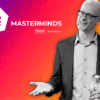

By Heleen Mes, Founder of HXWork & Author of Employee Experience; happy people, better business
WHY SHOULD YOU CARE?
Employee experience design has become increasingly important as organizations recognize the impact that employee engagement, retention, and productivity have on their bottom line. By prioritizing employee experience, organizations can create a competitive advantage, attract and retain top talent, and build a culture of excellence.
A great employee experience is not a fluke, nor does it happen automatically – you must design it! Employee experience design is a new HR skill that takes the employee experience to a higher level. Consequently, you avoid the most commonly made design mistakes.
Example: your HR team has devised a new solution for the organisation: an improved communication channel, a new way of onboarding, an app featuring HR KPIs or a thoughtful gesture for employees. The management team approves and you get to work. When it comes to HR matters, you’re the expert after all. You immerse yourself in solutions devised by other HR professionals and adapt their best practices to your organisation. Unfortunately, you must wait longer than expected for ICT, as your request was insufficiently budgeted. Nevertheless, by deploying some fancy communications, you ultimately manage to introduce the new solution. However, the initial enthusiasm within the organisation is rapidly dissipating, grumblings are heard and HR must continuously remind managers and employees to keep working with the new solution. Meanwhile, HR complains about a ‘lack of ownership’ and is disappointed by the outcome. Recognisable?
The 10 most common design mistakes
Where do things frequently go wrong within organisations? Why do new solutions fail to catch on? These are the most common mistakes:
- Jumping too quickly from problem to solution. We arrive at a solution without properly considering the actual problem – the problem behind the problem. Moreover, the solution does not seem to meet the actual need. The way to prevent this problem is to take a step back at the start and, together with the target group, to thoroughly examine the actual problem.
- Experts conceive and design for the target group instead of with them. In the traditional view of HR, we use our knowledge to ensure innovation transpires, yet the truly valued innovations are those that come from the employees themselves, with HR’s role being to gather their ideas and test them against the organisational frameworks: purpose, mission and core values. HR professionals and the target group collaborate in designing the solutions that best meet the need.
- Copying from other organisations. Each organisation must be as unique as its products and services. Being inspired is good, but copying is not… The point is to generate ideas that coincide with ‘what works best here’ instead of ‘what works best generally’.
- We start with ourselves. Your life, experiences, thought processes and expectations determine your perspective. Others may look at a situation completely differently. If you’re not careful, you will devise solutions that suit you, rather than those for whom the solution was intended. The first step therefore is to put yourself in your target group’s shoes.
- One size fits none. Everyone is different. What works for one person can be useless for another; if you really want to satisfy everyone’s needs, you must accept that fact. Working with various personas – fictional characters representing and enlivening specific target groups – is extremely helpful.
- Failing to properly assess importance for the target group, impact and frequency. An employee survey revealed a problem, yet you failed to determine how important the employees deem this problem to be. Or the problem’s impact and frequency were improperly assessed. This can result in a solution being devised for a problem that others actually consider unimportant, and hence they will not adopt the solution. Moreover, the effort invested is wasted. Or vice versa: a problem is not recognised as a priority.
- Above all it must be fun. And you can get a bit carried away with this dictum, causing irritation within the organisation: ‘Just get on with it!’ Or conversely: we forget that people pick things up faster if they are also fun to do. Of course it helps: fun makes it run. Yet solutions can also be extremely valuable if they save you lots of time, give new insights or boost your personal development.
- The solution was tested too late. The solution is virtually complete by the time you ask for user feedback. That’s too late! “Above all else, get a shitty first draft started,” says Luuk Sombezki, Employee Experience Lead at ABN Amro. “People will then dare to give feedback faster, because you clearly haven’t yet invested your soul and salvation and all your time into it. Consequently, you can make adjustments faster as well. The best solutions are developed along the way.”
- Gut feeling or hierarchy outweigh what really matters.During the design process, you can be influenced by the opinions of management, by those with the loudest voices, or rightly or wrongly by gut feelings. Yet what should really matter is the measured opinions of your target group. And the effects on crucial business and HR-KPIs.
- HR’s task is to design for the employees. HR starts out working alone, without involving other stakeholders. Everyone for themselves. But in this way you miss the interaction, support and insights of others, like ICT, facility management, communications, and managers. Consequently, the solution cannot contribute to an overall process that runs smoothly for all employees.
Employee experience design
Employee experience design is the art of designing a workplace experience that results in happy employees. Employee experience design draws on proven techniques from the worlds of marketing, product & user design, and psychology. It is a creative method for achieving new, innovative solutions for (complex) problems.
The fundamental principle of employee experience design always applies: people are central. End users and stakeholders are actively involved in the design or improvement of products and services. And this has major benefits, according to research conducted by McKinsey (2019): companies that reserve a primary role for design within the organisation are nearly twice as successful financially as their competitors.
Each organisation must define what the best employee experience is that it wants to offer, and to whom, yet all organisations share the same ultimate goal: to strengthen the bond between the organisation and employees, and allow their employees to experience more happiness at work.
Heleen Mes is an Employee Experience expert and founder of HXWork based in the Netherlands. Oracle named her as a top HR influencer in their 2018 annual report. Author of Employee Experience; happy people, better business. Her mission is to make every employer a top employer. She has over 25 years of experience in HR and she reached a top-10 position as ‘Best Employer’ with her companies twice. She is the founder of the LinkedIn group Employee Experience Nederland/België and editor of the news site Happy People Better Business News (www.hpbbnews.com).
Meet Heleen at The Employee Experience Forum in Amsterdam

Written by: Katalin Toth
Employee Experience Future of Work HR Strategy
Previous post

- 1386
labelArticles today2023.02.19.
Is your AI truly unbiased?
Mihaly Nagy, Partner, Head of Content, The HR Congress WHY SHOULD YOU CARE? Artificial Intelligence tools have the potential to help people professionals to boost productivity, efficiency and reliability. However, [...]
Similar posts

labelArticles today2024.10.21.
The success-recipe to build agile and future-ready organizations in 2025 and beyond








Post comments (0)